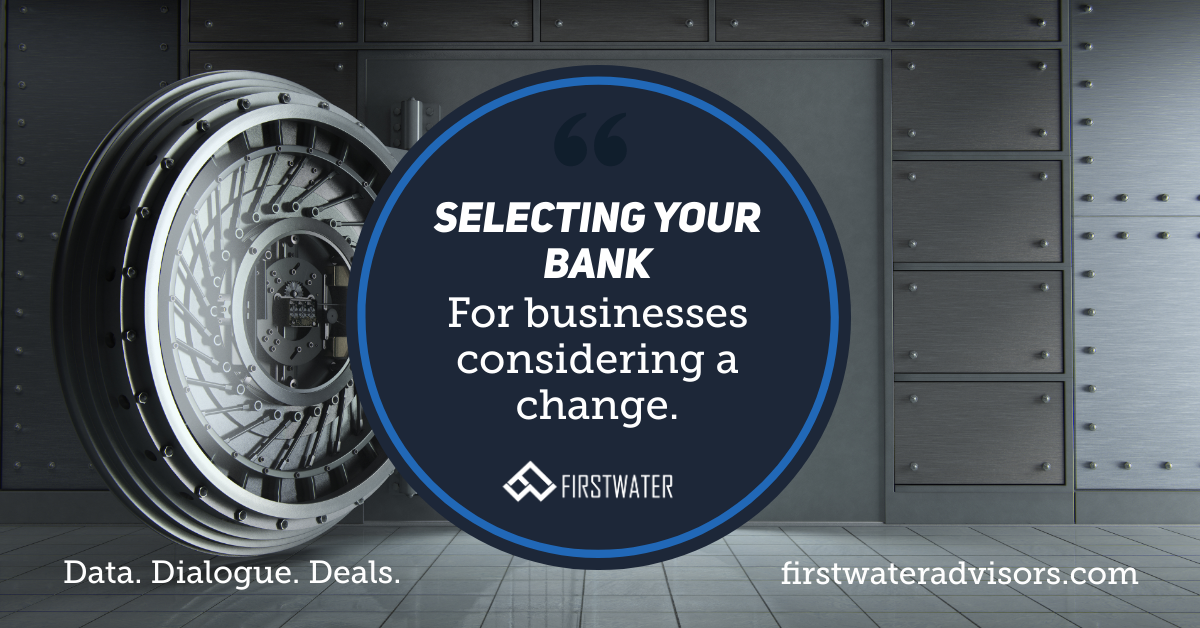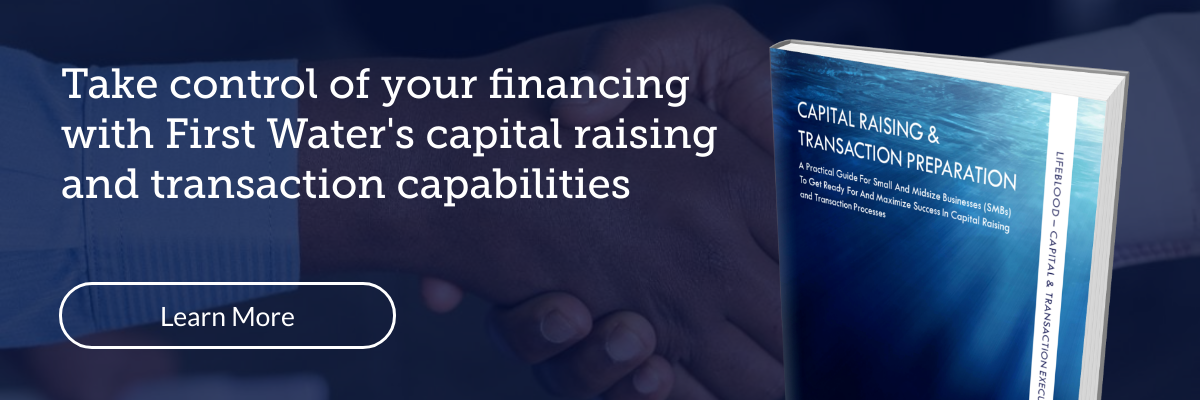Waded into a conversation string on LinkedIn where I didn’t know the original poster, a Founder & CEO, or those participating in the dialogue. I’m not including any names, so as not to call out anybody (other than myself).
Started something like this:
Original Poster: “I’ve had a horrible experience with Bank A. Got any recommendations for banks that are good with small businesses?”
Response 1: “Call my banker at Bank B.”
Response 2: “I hear Bank C, Band D, and Bank E are good.”
Response 3: “I also like Bank D.”
Response 4: “Bank F is who we currently use, and I’ve worked with Bank E previously.”
This didn’t make much sense to me. The poster ends up with a long list of banks to research and bankers to call, but no respondent knows why the Bank A experience was bad or the current and future banking needs of the business.
At First Water, we get involved in the banking relationships at most of our partner companies, often as the primary point of contact. Therefore, I felt I had the experience and the local contacts to offer a tailored referral. However, I didn’t have the business context. Plus, I know some good people at Bank A, so I didn’t want to explicitly or implicitly agree with the poster’s sentiment.
So I got up on a horse. Thought I would address my perceptions of the dialogue and pivot the conversation to the poster’s specific needs. My inline response mentioned how banking is getting tougher for small businesses, that individual banks are better at some things than others, and that in a regulated sector it’s hard to label a bank as “good” or “bad” ad infinitum. Provided basic examples of the considerations for current and future banking needs that would impact the selection decision.
The public forum that is LinkedIn called me out. Pointed to the poster’s background, a highly-educated tenured executive and how my comments spoke down to the CEO’s experience and sophistication. When I re-read my post, I understood how it could be taken that way. I deleted the post, reached out to the original poster directly, apologized, and sought feedback. The CEO confirmed that my post did not hit the mark, and accepted my apology. It was over, but I kept thinking about it.
Nothing in my post was incorrect, but it was presumptive and misplaced. I had no business thumping my chest about the pre-reqs for a referral to be of value (implicitly critiquing the referrals that had already been provided). I could have simply asked for more context, but prioritized presenting my knowledge to the social media universe. All done without effect for how my response might be interpreted within the string and LinkedIn at large, despite good intentions.
Egg on face. Feedback gained. Lesson learned. What I had written was more appropriate for a blog post…so here is that blog post. Bank relationships are critical for accessing capital, and if you’re here it is something you care about. So welcome, and I hope you will find this of value.
Your Banker is Not Your Bank
There was a time when your banker could get things done. True relationship banking where your banker’s individual knowledge of you and your business operated as the de facto credit committee. Then came regulations. Lots of them. Not just in making loan or credit extension decisions, but also in ongoing monitoring of the loan book. The box of what “fits” appears to be getting smaller and smaller.
This is especially true for small and midsize businesses (SMBs). Where large corporations have access to “covenant-lite” loans that can be underwritten and closed quickly, SMBs fight against extended processes, a “standard package” of covenants, personal guarantees, and/or collateral posting requirements that make many an entrepreneur wonder why they are paying interest to borrow against their own money.
These are just the rules of the game. You can despise it, deem it unfair, or not play, but none of these will get you more access to what is the cheapest cost of debt capital (at least measured by interest rates).
As you navigate this puzzle, your banker is doing the same. As an added kick in the pants, the rules keep changing, which is why bankers are trained not to telegraph how their bank will make decisions down the road. Nobody knows.
You still need your banker to go to bat for you, and excellent customer service is an expectation. A great banker proactively explains how changing rules and regulations impact your business (because that banker has taken the time to learn about your business and goals). Importantly, if you are frustrated with your banking relationship, find out whether your frustrations are bank-specific or are more regulatory-driven. The grass is not always greener.
Fitting Your Bank into Your Growth and Capital Roadmaps
Needs from your banking relationship are driven by your company’s goals, which you will always understand better than your bank. When selecting a new bank, at least as much consideration should be given to where you are planning to go versus where you are today. There are situations where today’s needs dominate the dialogue (e.g. your current bank declines to renew your line of credit), but even then there is value in understanding more about the future of the banking relationship.
This is a two-way assessment (by you and the prospective bank), and the key is forecasting. Think of it as a courtship governed by two C’s – capacity and credibility. Each serves different purposes, but a lack of either likely dooms your banking relationship to failure.
You want to grow your business, and you have a plan for it. More sales people, more inventory, more customers, more locations, more equipment. The sequencing, timing, and goals associated with these steps comprise the “growth roadmap” of the business. Now you need to finance it. From the bank’s perspective, the growth roadmap is a winding path of profitability, cash flow, and associated collateral; the different ways the growth roadmap may be financed (by the banks or others) is the “capital roadmap”.
The roadmaps need to be aligned, and a detailed build-up of the outlook fosters the capacity dialogue with the bank. We’re starting with a $1 million line of credit, but what if it needs to be $3 million within the next six months? Production is running full-tilt, so for expansion I need more equipment – can you provide $5 million of equipment financing against specialized machine A, B, C? With the backdrop of the forecast, limits to the bank’s capabilities (and appetite) are unearthed, allowing you to adjust the growth roadmap and/or proactively source other financing sources for specific needs.
These upfront roadmap conversations form the foundation for credibility in the relationship. Communicating the forward financing needs and showing real progress against the previously presented outlook evidences your business knowledge while minimizing surprises when its time to work on expanded financing. Nothing is guaranteed, as the world changes under our feet, but capacity and credibility remain necessities for a productive relationship.
Situational Expertise & Capabilities Do Exist
Even with the backdrop of the same regulatory framework, there are meaningful differences between banks which may be relevant for your needs. Size, location, history, loan exposures, even leadership can be the marginal determinant in getting something done.
Whenever we meet a bank we have not worked with before, we focus in on “win themes” to understand what types of specific financing situations would be the best opportunity to bring that bank into a selection process. Equally important to filtering is probing where the bank has less experience or appetite for exposure. Perhaps the biggest indicator of a great relationship banker is helping a customer source financing from a competitor, showing knowledge of 1) your needs, 2) the limits of one’s own bank, and 3) the specific strengths of other banks. Such situational referrals strengthen the relationship, not threaten it.
There are any number of circumstances where individual bank nuances come into play. We cannot cover them all, but will end with a short list of considerations and how the bank selection process might be impacted.
- Industry Exposure: This can have both positive and negative impacts. Significant exposure means a bank likely has a better understanding of your business and its customer/vendor universe. As a result, you may find it easier to deal with customer concentration issues or finance specialized equipment because the bank knows that market. On the flip side, when the tide turns in a cyclical sector, a bank with outsized exposure is more likely to pull back, which can impact you regardless of your company’s performance. The double-edged sword of knowledge and exposure is worth keeping tabs on.
- Underwriting Processes: Technology is embraced by banks. The largest banks have invested tens of billions of dollars in their technology infrastructure to keep up with the times. What can it mean for you? Faster underwriting and approval for certain types of financing can mean the difference in being able to agree to delivery terms on that big contract you’re negotiating. The weakness? Taking people partially out of the equation leaves less wiggle room for “story deals”; if you don’t check the boxes, the tech-driven process may work against you. Like all technology, it’s worth questioning (hello Skynet!).
- Local Market Knowledge: Buying a substantial piece of real estate? Selling primarily into local businesses? A bank in tune with the local marketplace may be able to finance you on better terms. This is especially true for real estate. On a significant purchase, a bank willing to go 10% more in loan to value (LTV) or offer 30-year amortization instead of 20 can be the difference in being able to do the deal at all and/or fit it into the cash flow limits of your business. Potential downside? If a bank only works locally/regionally, you may be out of luck down the road if your expansion plans extend beyond the border lines.
- Recourse Discourse: Is your first-born child encumbered? Outside of the ability to get a deal done, recourse via a personal guarantee (PG) is a major hot button issue for SMBs. Every bank has different thresholds for when they will partially or fully release a PG; however, not a single one of them will tell you exactly what is required in terms of profitability or relationship tenure, since the market future is unknown and your bank contact isn’t the credit committee. However, bankers will talk to you about their experience with other companies at their bank, their ability to use limited PGs for certain structures/collateral bases, and non-starters (“there is zero chance of us being able to do this without a PG”). Don’t skip the discourse on recourse.
Bank financing remains the lowest cost of capital available to financing and growing SMBs. However, it comes with limits and certain strings attached. Understanding where those strings are, who is pulling them, and which strings are relevant to your growth roadmap will set you up for bank success as long as you do your part in establishing credibility. Lastly, be kind to your bankers, who are not the same as the bank, and know that they navigate ever-increasing levels of red tape in all aspects of their day to day existence.






